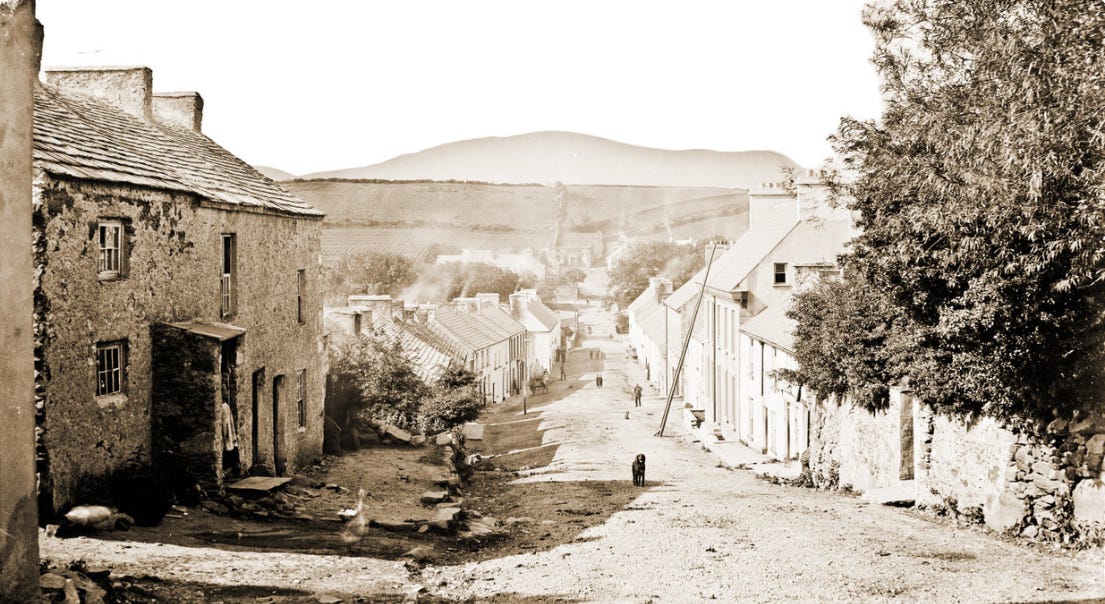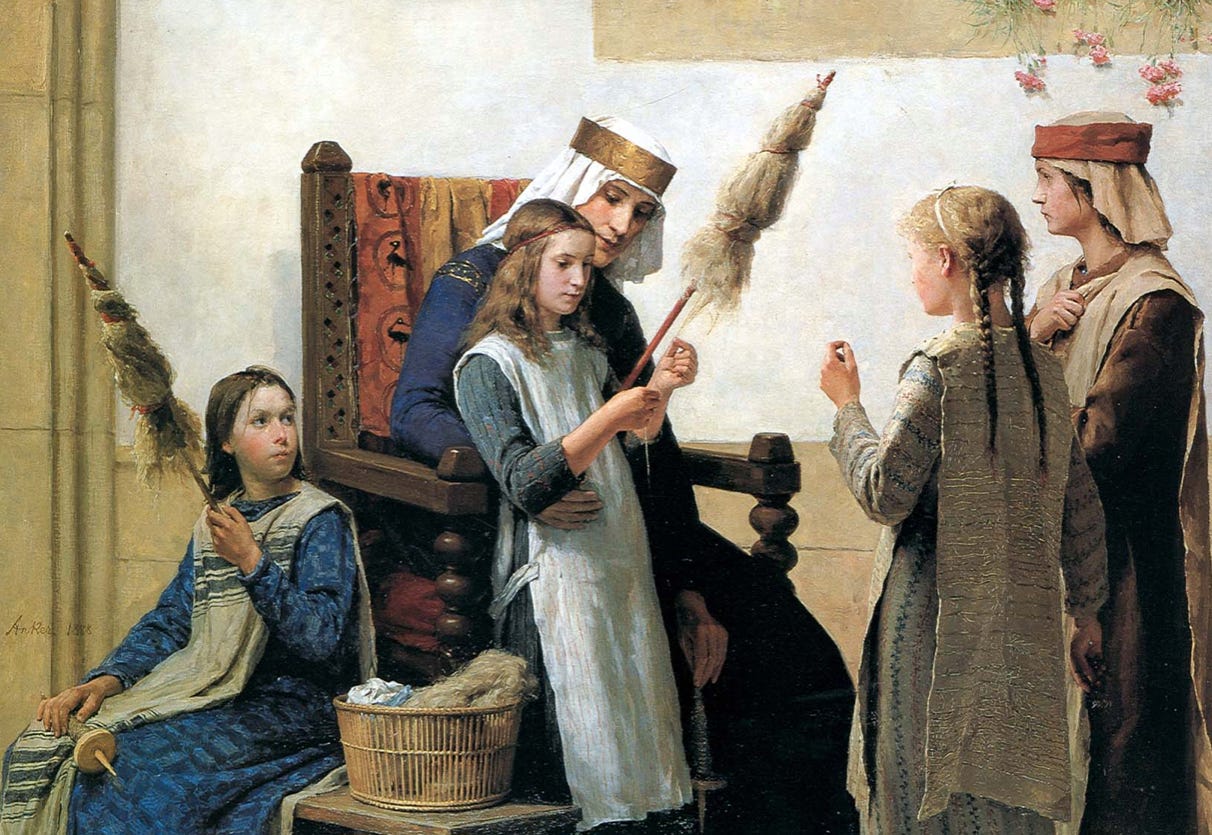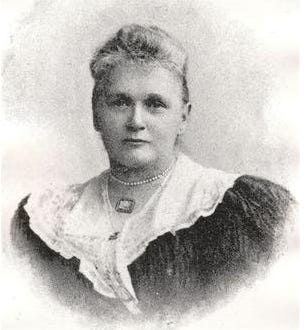
Hart and soul
In April 1883, Alice Hart and her husband Ernest journeyed from London to the Northwest corner of Ireland. After reading newspaper reports of the deprivation in Co Donegal, the philanthropically minded couple decided to investigate the situation.
If anyone was equipped for this mission, it was the Harts.
Alice had previously put her father’s oil fortune to good use by studying medicine in Paris and by teaching children in London slums.
Ernest was a successful physician and editor of the British Medical Journal.
Their previous experiences, however, had failed to prepare the Harts for the abject poverty they found in South Donegal.
One little town in particular caught Alice’s eye.
Surrounded by bog covered mountains, Ardara is a quaint little town by the sea, as are almost all towns here. The fishing and processing of herring was the main industry, but Alice Hart noticed the looms and spinning wheels lurking in the dark, smoke filled cottages, remnants of the previously thriving cottage industry of linen production.
People in Ardara had long replaced flax with wool from their flocks of sheep; the women spun the wool into yarn, which the men wove into tweed for their own blankets and clothing.
(The word tweed originates, not from the River Tweed in Scotland but from a Scottish merchant’s poor handwriting of ‘tweel’ or twill.)
In the 1880s, tweed was having a moment; the moisture resistant fabric was perfectly suited for the hunting jackets of the day.
Alice Hart had an inkling that Donegal tweed could rival the popular Scottish tweed and having decided that employment was the best way to alleviate poverty, she set up the Donegal Industrial fund.
No time was wasted; much needed capital and attention were raised through a media campaign, local weavers were employed to produce samples and within a year, Hart had opened a store devoted to the wildly popular Donegal tweed at 31 New Cavendish St., London.
A brilliant marketer, Alice Hart put the twee in tweed at the 1888 World Trade Fair in London; Donegal lace workers and weavers demonstrated their crafts against a backdrop of traditional thatched cottages and high crosses. The crowds loved it.
Ernest Hart unfortunately died soon after the project was started, but Alice continued to work tirelessly to grow the cottage industries of lace making, embroidery, weaving, knitting and crochet in Donegal.
The Donegal Industrial Fund unsurprisingly didn’t outlast Alice, who was the heart and soul of the project. Her dedication, ingenuity and creative direction brought much needed economic activity to the area and laid the groundwork for 100+ years of industry.
Working from home 1.0
Cottage industry wasn’t a new idea in the 1880s; the spinning wheels and looms Alice Hart found in cottages had been distributed a hundred years earlier as premiums paid to flax growers and weavers. In one year alone in the 1700s, 6,000 wheels and looms were distributed in Donegal.
Cottage industry was also know as the domestic, workshop or putting-out systems.
The putting out system was a means of subcontracting work (or rather, is; contemporary examples can be found in China, India, and South America).
Using raw materials from local farms or from merchants, workers would produce textiles in their homes and then bring the finished cloth to a nearby town to be sold.
There were numerous advantages to this system of working from home, as we re-discovered in 2020; people could earn from very remote locations, while balancing farm and house work. Little fingers could be put to use (I meant, entertained). You could work at your own speed, in safe surroundings during long winter nights. On the other side of the equation, the merchant gained access to a large pool of native skills with very little overhead.
Cottage industry is considered to be a form of proto-industrialization and is often cited as one of the causes of the rise of the nuclear family in Europe, as the large amount of profits gained by common people made them less dependent on their extended family.
Though the system could and would eventually be abused by middlemen, it was very successful in creating a wealthier peasant class in Western Europe with more furniture, food, and clothing than before.

The Congested Districts Board
Alice Hart was approximately 10 years ahead of the British government; in 1891, the Congested Districts Board for Ireland was established.
A strangely humanitarian project, the stated purpose was to alleviate poverty by paying for public works to give employment and stop emigration from Ireland.
The equally ambitious implicit aim of the project was to ‘kill Home Rule with kindness’.
The Congested Districts Board had some success; the Hart model was used to establish a knitwear industry on the Aran Islands (you may have heard of Aran jumpers!).
But as the Irish historian Joseph Lee summarised: "The Board's promise, in short, generally far exceeded its performance".
The Board needed support on the ground, so rather than loaning capital to existing businesses, subsidies were advanced to parish councils run by priests. Somewhat predictably, the Bishop of Raphoe (who was the youngest bishop in the world at that time) spent £100,000 on a cathedral and college in Letterkenny, a town with only 2000 inhabitants in 1888.
In retrospect, the attempt to curry favour with the Catholic church was disastrous; the Congested Districts Board ultimately funded the building of industrial schools, the legacy of which is still being dealt with.
And not to spoil the ending, but Home Rule wasn’t killed with kindness.
Fair weather ahead
Thanks to Alice Hart’s foundational work and the initiatives of the Congested Districts Board, Ardara had developed a famous yarn market, held on the first day of every month. An 1899 account featured in Lochlann McGill’s book ‘In Conall’s Footsteps’ describes hordes of men and women walking from every direction towards the town with a large bundle on their backs wrapped in a white cloth and slung in a rope made of twisted rushes. Walking over mountains and streams, sometimes through the night, these Irish speakers filled the town with bundles of soft coloured homespun cloth; after inspection and haggling, they were paid good prices and set off on their homeward journeys once again.
With established markets and a strong cottage industry, Ardara was in a unique position during WWI, which created huge demand for tweed and woven wool fabrics. The boom continued until mid-1922; in the proceeding year, £70,000 was paid to cottage producers for tweed sold in Ardara alone.
By the mid 1920s, the newly formed Irish Free State had an enormous amount of emotional baggage and economic woes to boot. Local rates and Government charges sky-rocketed as the cottage industries of knitting, spinning, weaving and lace-making declined.
The local population dwindled through emigration and tales of the yarn market grew taller and then smaller, until very few people indeed remembered Fair day.

Symbiosis
Between writing the definitive book on Donegal Tweed and burying her husband in the back garden, Judith Hoad has had an interesting life.
As a young dressmaker, Judith disliked working for other people, set up her own label Judith of Canterbury and met her husband while making costumes for a West End play. Amen to all that.
The young couple decided Wales wasn’t isolated enough and in a fit of inspired action, moved their family to a distinctly isolated cottage in Slieve League, Co Donegal. In a Dec 2020 interview, she recalls being welcomed warmly to Donegal with courteous handshakes and greetings of ‘Welcome to this land’.
As she settled into the area, Judith was fascinated to learn about the cottage industry of home weaving and wool dyeing, which, by the late 1980s, was beginning to disappear.
She sensed an unwritten book and proceeded to pedal around South Donegal in search of material.
All that peddling paid off; ‘This is Donegal Tweed’ by Judith Hoad is a splendid book which captures a moment of time and still stands as a excellent source.
"Only a generation ago, Donegal Tweed embodied the integration between the sheep, the plants (used in the dyeing process) and the human population of its place of production – a kind of symbiosis existed. That symbiosis in the domestic production of tweed has disappeared. Mechanised, factory production may clothe more people, but it is in essence impersonal. The individuality…has gone. I'm a Luddite at heart and I mourn its passing."
This is Donegal Tweed" by Judith Hoad. Shoestring Publications, Inver, Co Donegal 1987
Peaks and troughs
Clearly, what are politely referred to as the ‘peaks and troughs’ of the Irish woollen industry are closely linked to global economic activity.
Larry Fink, the CEO of Blackrock, has mournfully declared the current instability in Ukraine marks an end of globalisation; an unsettling, but ultimately necessary correction.
With worsening supply chain issues and chronic under-employment comes the silver lining of an absolute explosion of interest in truly sustainable products. Conscious consumers are concerned about environmental and labour standards.
What remains of local industry should take note.
Ardara still exists and is home to several family-owned knitwear and tweed operations. Several mills and studios of varying sizes continue to produce exemplary yarns and textiles in South Donegal.
Tourists are as rare as hens’ teeth these days and exports keep the knitwear industry alive; their products are seldom seen being worn by Irish people.
The recent resurgence in knitting has resulted in a large increase in yarn sales.
An Irish wool feasibility study is to be published this month by the Department of Agriculture for the tidy sum of €100,000. (Remember that number?).
Small co-operative groups of sheep farmers have started to emerge and the mills, to their credit, have started to produce pure Irish wool yarns.
A unique position
Donegal is a place rich with ghosts of the past; bog roads built by hand are reminders of the Great Famine, empty houses are symbols of the ceaseless stream of emigration.
Growing up just a little ways from Ardara, I remember the eerie silence of an idle loom after a classmate’s grandfather passed away; no one knew how to use it.
But the cottage industry skills are not quite extinct.
A recent ad for handknitters on the Irish Countrywomen’s association Facebook page yielded thousands of responses. The ad notably failed to mention compensation and judging by the comments, not all memories of cottage industry knitting are fond. Older people recalled sweltering under huge jumpers in July & piecemeal work with scant pay which preyed on local women without any unions or representation.
What prompted this ad, you might ask?
Taylor Swift wore a cabled cardigan.
Once again, we Irish people find ourselves in a unique position.
We are rich, not in the Larry Fink sense of the word, but rich in wool, rich in history, rich in creativity and rich in youth.
The internet is teeming with crafting education and potentially life-giving market connections.
We need a native industry that uses Irish wool to provide well paid employment, much needed socialisation, rural community development and creative expression.
Cottage industry may be the answer.
We need to protect skilled workers; the sheer greed of middlemen cannot be allowed to eliminate these crafts.
We need to prioritise makers over managers.
We need simple stylish designs, which are worn widely, independent of the whims of celebrity stylists.
We need to start now.
Or the question will be (and perhaps already is) who is the next Alice Hart?
Dr Aoife Long is a fashion writer by night and a creative director at Spirit and Luxury by day.





Thank you for this Aoife, I so enjoyed reading and learning about the history. I believe it is the perfect "window" for a native industry. Perhaps you are the next Alice Hart xx